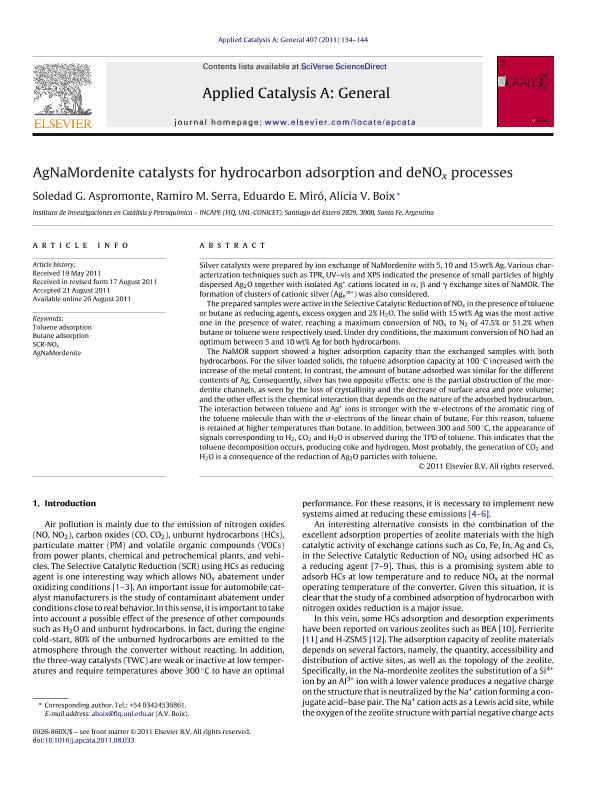Mostrar el registro sencillo del ítem
dc.contributor.author
Aspromonte, Soledad Guadalupe

dc.contributor.author
Serra, Ramiro Marcelo

dc.contributor.author
Miro, Eduardo Ernesto

dc.contributor.author
Boix, Alicia Viviana

dc.date.available
2018-07-23T19:03:31Z
dc.date.issued
2011-11
dc.identifier.citation
Aspromonte, Soledad Guadalupe; Serra, Ramiro Marcelo; Miro, Eduardo Ernesto; Boix, Alicia Viviana; AgNaMordenite catalysts for hydrocarbon adsorption and deNOx processes; Elsevier Science; Applied Catalysis A: General; 407; 1-2; 11-2011; 134-144
dc.identifier.issn
0926-860X
dc.identifier.uri
http://hdl.handle.net/11336/52871
dc.description.abstract
Silver catalysts were prepared by ion exchange of NaMordenite with 5, 10 and 15 wt% Ag. Various characterization techniques such as TPR, UV-vis and XPS indicated the presence of small particles of highly dispersed Ag2O together with isolated Ag+ cations located in α, β and γ exchange sites of NaMOR. The formation of clusters of cationic silver (Agnm+) was also considered. The prepared samples were active in the Selective Catalytic Reduction of NOx in the presence of toluene or butane as reducing agents, excess oxygen and 2% H2O. The solid with 15 wt% Ag was the most active one in the presence of water, reaching a maximum conversion of NOx to N2 of 47.5% or 51.2% when butane or toluene were respectively used. Under dry conditions, the maximum conversion of NO had an optimum between 5 and 10 wt% Ag for both hydrocarbons. The NaMOR support showed a higher adsorption capacity than the exchanged samples with both hydrocarbons. For the silver loaded solids, the toluene adsorption capacity at 100 °C increased with the increase of the metal content. In contrast, the amount of butane adsorbed was similar for the different contents of Ag. Consequently, silver has two opposite effects: one is the partial obstruction of the mordenite channels, as seen by the loss of crystallinity and the decrease of surface area and pore volume; and the other effect is the chemical interaction that depends on the nature of the adsorbed hydrocarbon. The interaction between toluene and Ag+ ions is stronger with the π-electrons of the aromatic ring of the toluene molecule than with the σ-electrons of the linear chain of butane. For this reason, toluene is retained at higher temperatures than butane. In addition, between 300 and 500 °C, the appearance of signals corresponding to H2, CO2 and H2O is observed during the TPD of toluene. This indicates that the toluene decomposition occurs, producing coke and hydrogen. Most probably, the generation of CO2 and H2O is a consequence of the reduction of Ag2O particles with toluene.
dc.format
application/pdf
dc.language.iso
eng
dc.publisher
Elsevier Science

dc.rights
info:eu-repo/semantics/openAccess
dc.rights.uri
https://creativecommons.org/licenses/by-nc-sa/2.5/ar/
dc.subject
Agnamordenite
dc.subject
Butane Adsorption
dc.subject
Scr-Nox
dc.subject
Toluene Adsorption
dc.subject.classification
Otras Ingeniería Química

dc.subject.classification
Ingeniería Química

dc.subject.classification
INGENIERÍAS Y TECNOLOGÍAS

dc.title
AgNaMordenite catalysts for hydrocarbon adsorption and deNOx processes
dc.type
info:eu-repo/semantics/article
dc.type
info:ar-repo/semantics/artículo
dc.type
info:eu-repo/semantics/publishedVersion
dc.date.updated
2018-07-20T14:18:50Z
dc.journal.volume
407
dc.journal.number
1-2
dc.journal.pagination
134-144
dc.journal.pais
Países Bajos

dc.journal.ciudad
Amsterdam
dc.description.fil
Fil: Aspromonte, Soledad Guadalupe. Consejo Nacional de Investigaciones Científicas y Técnicas. Centro Científico Tecnológico Conicet - Santa Fe. Instituto de Investigaciones en Catálisis y Petroquímica "Ing. José Miguel Parera". Universidad Nacional del Litoral. Instituto de Investigaciones en Catálisis y Petroquímica "Ing. José Miguel Parera"; Argentina
dc.description.fil
Fil: Serra, Ramiro Marcelo. Consejo Nacional de Investigaciones Científicas y Técnicas. Centro Científico Tecnológico Conicet - Santa Fe. Instituto de Investigaciones en Catálisis y Petroquímica "Ing. José Miguel Parera". Universidad Nacional del Litoral. Instituto de Investigaciones en Catálisis y Petroquímica "Ing. José Miguel Parera"; Argentina
dc.description.fil
Fil: Miro, Eduardo Ernesto. Consejo Nacional de Investigaciones Científicas y Técnicas. Centro Científico Tecnológico Conicet - Santa Fe. Instituto de Investigaciones en Catálisis y Petroquímica "Ing. José Miguel Parera". Universidad Nacional del Litoral. Instituto de Investigaciones en Catálisis y Petroquímica "Ing. José Miguel Parera"; Argentina
dc.description.fil
Fil: Boix, Alicia Viviana. Consejo Nacional de Investigaciones Científicas y Técnicas. Centro Científico Tecnológico Conicet - Santa Fe. Instituto de Investigaciones en Catálisis y Petroquímica "Ing. José Miguel Parera". Universidad Nacional del Litoral. Instituto de Investigaciones en Catálisis y Petroquímica "Ing. José Miguel Parera"; Argentina
dc.journal.title
Applied Catalysis A: General

dc.relation.alternativeid
info:eu-repo/semantics/altIdentifier/doi/https://doi.org/10.1016/j.apcata.2011.08.033
dc.relation.alternativeid
info:eu-repo/semantics/altIdentifier/url/https://www.sciencedirect.com/science/article/pii/S0926860X11004881
Archivos asociados
